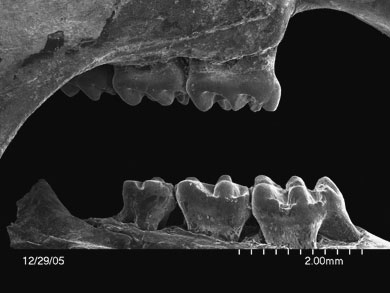
A New Species of Megacricetodon (Cricetidae, Rodentia, Mammalia) from the Middle Miocene of Northern Junggar Basin, China.
Shundong Bi1, Jin Meng2, and Wenyu Wu3
1 Department of Biology, Indiana University of Pennsylvania, Indiana, PA 15705. Research Associate, Section of Vertebrate Paleontology, Carnegie Museum of Natural History. 2 Division of Paleontology, American Museum of Natural History.3 Institute of Vertebrate Paleontology and Paleoanthropology, Chinese Academy of Sciences, Beijing 100044, China.
Dental, mandibular, and postcranial specimens of Megacricetodon yei n. sp., are described. The new specimens, including the complete dentition, mandible, and partial forelimb and hindlimb, represent the most complete materials known for the genus, provide valuable information concerning the interspecific variation of the genus, and lead to the reassessment of the suprageneric position of Megacricetodon.
Megacriectodon yei is characterized by having medium-size, clearly split anterocone of M1, presence of the labial spur of the anterolophule and the posterior spur of the paracone in some M1s, medium to long mesoloph in M1-2, frequent occurrences of double protolophules, transverse or posteriorly directed metalophule of M2, and single anteroconid of the m1. Megacricetodon yei is more closely related to Megacricetodon (= Aktaumys) dzhungaricus than to any other species of Megacricetodon, but is more derived than the latter. Based on the new information, the validity of the genus Aktaumys is discussed.
The postcranial features of Megacricetodon yei show clear adaptations for terrestrial habits, but as in many ground-dwelling rodents living in burrows, it could also climb or dig. The associated fauna has been correlated to Tongxin fauna from the adjacent part of China and the Belometchetskya fauna of north Caucasus, equivalent to early Middle Miocene age, or MN 6 correlative. The stage of evolution of Megacricetodon yei is consistent with the faunal correlation.
Jin Meng is an Associate Curator at the Museum's Department of Paleontology.